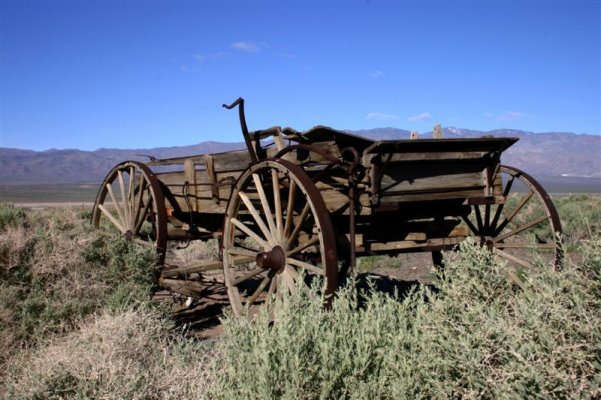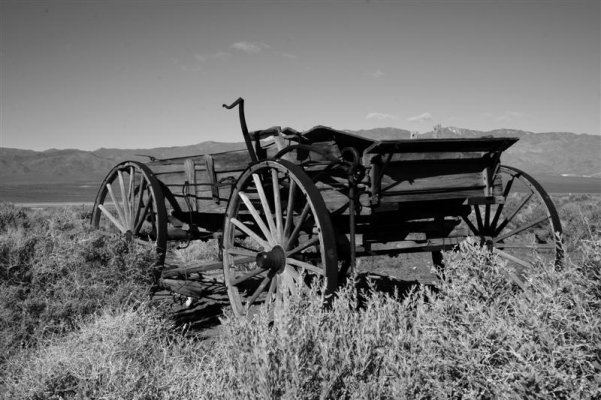You are using an out of date browser. It may not display this or other websites correctly.
You should upgrade or use an alternative browser.
You should upgrade or use an alternative browser.
Death Valley in black & white
- Thread starter DougJ
- Start date
The friendliest place on the web for anyone with an RV or an interest in RVing!
If you have answers, please help by responding to the unanswered posts.
If you have answers, please help by responding to the unanswered posts.
Jim Dick
Moderator Emeritus
DougJ said:Why, oh why, would you show something from Death Valley (very recent) in black and white?
This link:
http://www.fredmiranda.com/forum/topic/202281
may give you an answer.
The Fred Miranda web site is one of my favourite haunts.
Ciao,
Doug
Doug,
Great photo! There are many times when black & white portray a much better story than color. I often try converting to B&W to see what the results will show. I've attached a photo I took on the way to Death Valley. One is color and the other b&w. I like the b&w better though the tone seems a little off. Another lesson to learn from PS.
Attachments
Karl
Moderator Emeritus
Why black and white? Ansel Adams, one of the all-time great photog's, never shot a picture in color. While color can be spectacular for many subjects, the nuances of highlight, shadow, texture and many more things are lost in the great splashes of color for many select subjects. As Jim said, try them in b/w or even a sepia or selenium (blue) tone to capture the apparent age of your subject. You may be pleasantly surprised. The wooden wagon is an excellent example.
Ron
Moderator Emeritus
kkolbus said:Why black and white? Ansel Adams, one of the all-time great photog's, never shot a picture in color. While color can be spectacular for many subjects, the nuances of highlight, shadow, texture and many more things are lost in the great splashes of color for many select subjects. As Jim said, try them in b/w or even a sepia or selenium (blue) tone to capture the apparent age of your subject. You may be pleasantly surprised. The wooden wagon is an excellent example.
I agree completely. The instructor in a photography class I was in in the early 60/s frequently made a statement that went something like this " color photography is easy it take a real artist to photograph in black and white." Another thing I remember this guy said was learn to photograph in Black and white then it is easy to adapt to color.
Now I never gained the appreciation he had for black and white photos but there is a talent required to do B&W photography properly. I don't think I have shot anything in B&W since the 70/s
Lorna
Well-known member
- Joined
- Mar 7, 2005
- Posts
- 1,183
That is an outstanding BW and the setup. Jim I like both of yours, they are great shots. I have never taken BW but some of my family really take some great BW. Ned used to do BW and do his own developing. Guess if I wanted to take BW I would have to take some classes and since I have never had any formal training in photography that would be a whole new experience. I like making pictures not just taking them.
Karl
Moderator Emeritus
Lorna,
As you well know, I've seen many of your photos. While you may not have had any formal training, you have a natural 'eye' for composition; something that many strive for but few achieve. When you take a color picture that you think might look good in b/w, think 'black and white' and try to visualize the scene without color; that will make things much easier. Years ago (and still today to some extent) photog's would shoot with panchromatic b/w film which is insensitive to reds, so they had to visualize how the finished shot would turn out (reds appear black). Grey scale range is another important factor to take into account, that is, if you expose for shadow detail, what will happen to the highlites - will they be washed out? Some of this can be corrected in the darkroom, but if the details are missing from the original, there's no way to recover them in the final print (short of redeveloping; but that's a whole other subject). Many people use PhotoShop, a very good editing program, but I use Microsoft Image Composer and/or Kodak "Picture It '99"; both free and included with Windows 98 and the Kodak DC-240 camera (respectively) I used to have. Picture It is somewhat limited but does an amazingly good job of removing scratches and dust specks from old photos.
As you well know, I've seen many of your photos. While you may not have had any formal training, you have a natural 'eye' for composition; something that many strive for but few achieve. When you take a color picture that you think might look good in b/w, think 'black and white' and try to visualize the scene without color; that will make things much easier. Years ago (and still today to some extent) photog's would shoot with panchromatic b/w film which is insensitive to reds, so they had to visualize how the finished shot would turn out (reds appear black). Grey scale range is another important factor to take into account, that is, if you expose for shadow detail, what will happen to the highlites - will they be washed out? Some of this can be corrected in the darkroom, but if the details are missing from the original, there's no way to recover them in the final print (short of redeveloping; but that's a whole other subject). Many people use PhotoShop, a very good editing program, but I use Microsoft Image Composer and/or Kodak "Picture It '99"; both free and included with Windows 98 and the Kodak DC-240 camera (respectively) I used to have. Picture It is somewhat limited but does an amazingly good job of removing scratches and dust specks from old photos.
Jim Dick
Moderator Emeritus
Lorna said:That is an outstanding BW and the setup. Jim I like both of yours, they are great shots. I have never taken BW but some of my family really take some great BW. Ned used to do BW and do his own developing. Guess if I wanted to take BW I would have to take some classes and since I have never had any formal training in photography that would be a whole new experience. I like making pictures not just taking them.
I, too, used to develop and print my own b&w but a lot of it. I just remembered my favorite b&w was also an old wagon in a stream. ;D
Lorna
Well-known member
- Joined
- Mar 7, 2005
- Posts
- 1,183
Karl thanks for the compliment.


